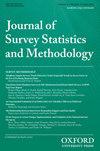基于分层随机斜率独立编码的访谈者群体调查参与效应建模
IF 1.6
4区 数学
Q2 SOCIAL SCIENCES, MATHEMATICAL METHODS
引用次数: 0
摘要
尽管在调查参与方面很重要,但关于面对面访谈者如何不同地影响特定样本单位群体的文献很少。本文演示了多层模型中随机成分的另一种参数化,即所谓的独立编码,如何为特定样本成员组的差异访谈者效应提供有价值的见解。在一个基于概率的在线小组的面对面招聘面试的例子中,我们发现对于非互联网家庭的调查参与,面试官的影响很小,而对于互联网家庭,我们发现面试官的影响很大。我们为调查从业者提供实用的指导,以解决基于建议的方差分解的不同访谈者效应。本文章由计算机程序翻译,如有差异,请以英文原文为准。
Modeling Group-Specific Interviewer Effects on Survey Participation Using Separate Coding for Random Slopes in Multilevel Models
Despite its importance in terms of survey participation, the literature is sparse on how face-to-face interviewers differentially affect specific groups of sample units. This paper demonstrates how an alternative parametrization of the random components in multilevel models, so-called separate coding, delivers valuable insights into differential interviewer effects for specific groups of sample members. In the example of a face-to-face recruitment interview for a probability-based online panel, we detect small interviewer effects regarding survey participation for non-Internet households, whereas we find sizable interviewer effects for Internet households. We derive practical guidance for survey practitioners to address differential interviewer effects based on the proposed variance decomposition.
求助全文
通过发布文献求助,成功后即可免费获取论文全文。
去求助
来源期刊
CiteScore
4.30
自引率
9.50%
发文量
40
期刊介绍:
The Journal of Survey Statistics and Methodology, sponsored by AAPOR and the American Statistical Association, began publishing in 2013. Its objective is to publish cutting edge scholarly articles on statistical and methodological issues for sample surveys, censuses, administrative record systems, and other related data. It aims to be the flagship journal for research on survey statistics and methodology. Topics of interest include survey sample design, statistical inference, nonresponse, measurement error, the effects of modes of data collection, paradata and responsive survey design, combining data from multiple sources, record linkage, disclosure limitation, and other issues in survey statistics and methodology. The journal publishes both theoretical and applied papers, provided the theory is motivated by an important applied problem and the applied papers report on research that contributes generalizable knowledge to the field. Review papers are also welcomed. Papers on a broad range of surveys are encouraged, including (but not limited to) surveys concerning business, economics, marketing research, social science, environment, epidemiology, biostatistics and official statistics. The journal has three sections. The Survey Statistics section presents papers on innovative sampling procedures, imputation, weighting, measures of uncertainty, small area inference, new methods of analysis, and other statistical issues related to surveys. The Survey Methodology section presents papers that focus on methodological research, including methodological experiments, methods of data collection and use of paradata. The Applications section contains papers involving innovative applications of methods and providing practical contributions and guidance, and/or significant new findings.

 求助内容:
求助内容: 应助结果提醒方式:
应助结果提醒方式:


